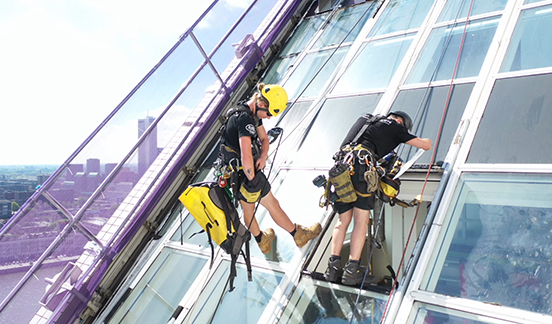This course provides the knowledge in safe procedures for rope access work according to the level at which you apply.
Standardize procedures and maneuvers to perform safe rope access work.
The focus of this training is 95% practical training and 5% theory.
WHAT IS THE OBJECTIVE OF THE COURSE?
Prepare the applicant to take the theoretical and practical evaluation carried out by an external evaluator assigned by APETAC (Peruvian Association of Companies and Technicians in Access by Ropes).
WHO IS IT AIMED AT?
People who are dedicated or want to dedicate themselves to performing work using rope access techniques with a high level of security. These people can be welders, painters, glass cleaners, scaffold erectors, quality inspectors, non-destructive testing (NDT) people, etc. And that they have to reach workplaces that are difficult to access by access experts.
WHAT ARE THE DIFFERENT LEVELS AT?
There are three (3) levels to which you can apply in the APETAC system, having a base of requirements in calendar time to be able to apply from one level to another, which cannot be less than six months and in addition, a minimum of 500 must be supported hours worked to be able to move from one level to another higher.
APPLICANT FOR LEVEL I SPECIALIST
It is the person, with or without experience, interested in wanting to obtain a Level I Rope Access Technician certification.
- Minimum age of 18 years
- Acceptable physical condition
- Do not suffer from acrophobia (pathological fear of heights that manifests
often with vertigo)
APPLICANT FOR LEVEL II SPECIALIST
It is the person who already has a Level I APETAC certification or equivalent that can be validated.
- Minimum age of 20 years.
- Good physical condition.
- 180 days of validity of your Level I certification.
- 500 sustained hours of work experience in Level I rope access.
APPLICANT FOR LEVEL III SPECIALIST
It is the person who already has a Level II rope access certification, be it from APETAC or equivalent that can be validated.
- Minimum age of 22 years
- Good physical condition
- 180 days of validity of your Level II certification
- 500 sustained hours of work experience in rope access
Level I and Level II. - Current certificate in urban and / or wild first aid.
- Presentation of Procedure for the development of vertical project.
WHAT IS THE TEACHING METHOD?
A “Learning by doing” methodology is implemented, in which participants will have to carry out practical activities so that they are aware of what they are doing. They will be able to make mistakes, correct them and improve them because 90% of what we experience and only 40% of what we hear and see is learned.
WHAT WILL THE EVALUATION LOOK LIKE?
The Evaluator will rate the final performance of the applicant during his exam at the corresponding level. This evaluation comprises two sub-processes, which will be directly related to the final qualification of the applicant. The Evaluator reserves the final form in which it will execute its evaluation at her discretion. These evaluative threads are:
- Theoretical Exam
- Practical Exam
At the beginning, we specialized in commercial buildings and then started with industrial buildings, where the requirements of the MASE certification (Manual for the Improvement of the Security of the companies) allowed us to structure ourselves better. The industry is one of the media where rope work situations are very varied but also more demanding. The response must be fast, effective, and safe. For example, in 1997, a client asked us to clean the inside of a 90 m high boiler with accumulations of slag, especially lime. We mobilized all the workers of the company, divided into day and night shifts; we acquired new equipment such as self-ventilated masks for all participants. In times when safety and efficiency are essential, the cohesion and identity of the company are built. Strong bonds are established between team members, and their shared experience can help the company for future projects.
We are currently managing works of great intensity, such as recently the complete restoration of a 145 m high combustion chimney in Martigues. For the company, it meant stopping production for three weeks and us, more than 2000 hours of work (a new application of epoxy paint, the repair of the catwalks and safety ladders, change of the pipes, the fixing braces and the nozzle burner, repair the light beacon system and inspect all welds).

